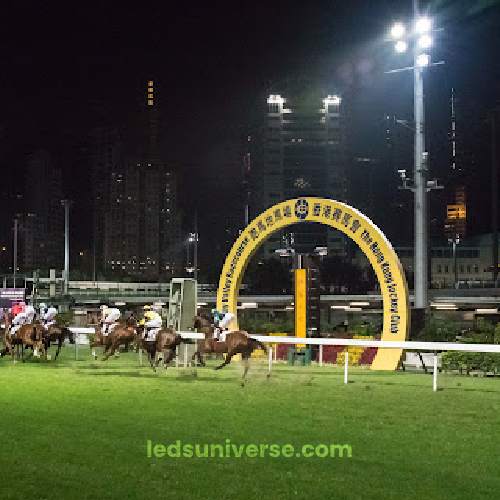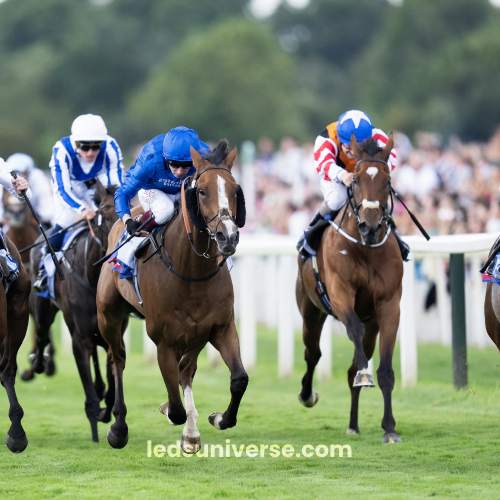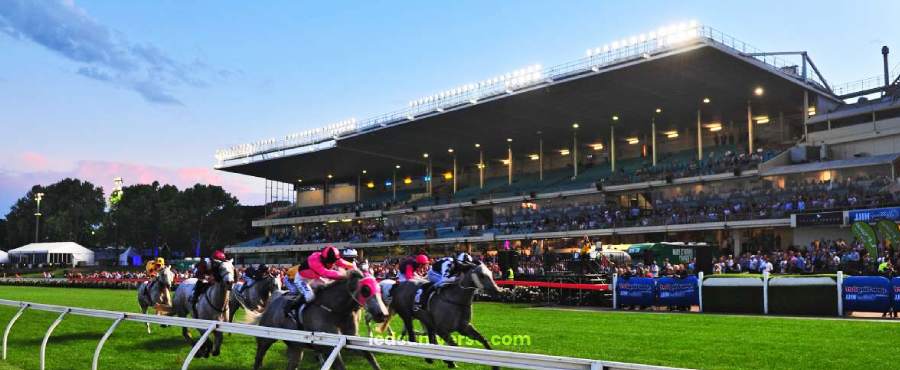As the thrilling world of horse racing evolves, so too does the technology that lights up the tracks where excitement unfolds. The quest for the perfect racecourse lighting solution has led to a dramatic shift from traditional fixtures to cutting-edge technologies like LEDs, floodlights, and spotlights.
As the sport evolves, so does the technology behind racecourse illumination. With advancements in LED technology and improvements in broadcasting standards, racecourse lighting has become more sophisticated, providing optimal visibility for both participants and spectators.
Reach out for free lighting consultation
Table of Contents
ToggleLED technology has significantly transformed racecourse lighting, offering numerous advantages over traditional lighting solutions. LEDs (Light Emitting Diodes) are highly valued for their energy efficiency, longevity, and exceptional light quality. Unlike incandescent or halogen lights, which consume more power and have shorter lifespans, LEDs use substantially less energy while providing a brighter, more focused beam.
In racecourses, LEDs are especially beneficial because they deliver consistent illumination across the track. This is crucial for both daytime and nighttime events, ensuring that the entire area is well-lit without creating harsh shadows or uneven lighting. The ability to adjust the brightness and color temperature of LEDs allows for tailored lighting solutions that can adapt to different racing conditions and times of day.

One of the standout features of LED lighting is its durability. LEDs are designed to withstand various environmental conditions, making them ideal for the often harsh weather conditions encountered in outdoor settings. Their robust build means they are less likely to suffer from issues like breakage or dimming over time, which contributes to their cost-effectiveness and reliability.
Moreover, LEDs are known for their low maintenance requirements. Their long lifespan reduces the frequency of replacements, saving both time and money in the long run. This makes them an excellent choice for racecourses where maintaining optimal lighting conditions is crucial for both safety and performance.
Floodlights are a staple in racecourse lighting due to their ability to illuminate large areas with high-intensity light. These fixtures are typically mounted on high masts, which can reach heights of up to 50 meters. The elevated positioning helps to achieve even light distribution across the racecourse, minimizing shadows and ensuring that the entire track is uniformly lit.
Modern floodlights come equipped with advanced features that enhance their functionality. Adjustable angles allow for precise control over the direction of the light, which helps in targeting specific areas of the track or adjusting the coverage based on the requirements of different events. Additionally, many floodlights have dimming capabilities, enabling operators to modify the light intensity according to the time of day or the particular needs of a race.
The design of floodlights often incorporates high-efficiency optics and reflectors that maximize light output while reducing energy consumption. This is crucial for racecourses where maintaining bright, consistent lighting is necessary for both the safety of the participants and the enjoyment of the spectators.
In terms of durability, floodlights are built to withstand the rigors of outdoor use. They are typically constructed with weather-resistant materials and designed to handle various environmental conditions, including rain, wind, and extreme temperatures. This robustness ensures that the lighting system remains operational and effective throughout its lifespan.
These fixtures are commonly used to highlight key parts of the racecourse, such as the finish line, jockeys’ mounting area, and other critical zones that require detailed illumination.
Spotlights are versatile and can be manually or automatically adjusted to direct light precisely where it is needed. Manual spotlights allow for flexibility in adjusting the angle and focus, which is beneficial for adapting to different racing conditions or special events. Automatic spotlights, on the other hand, offer the convenience of remote control and pre-programmed settings, making it easier to adjust the lighting quickly and efficiently during live races.
The use of spotlights enhances the viewing experience for spectators by ensuring that crucial areas of the track are well-lit and visible. This is particularly important for capturing high-resolution images and videos, which are essential for media coverage and broadcasting.
In addition to their role in highlighting specific areas, spotlights also contribute to the overall safety of the racecourse. By providing targeted illumination, they help to reduce the risk of accidents and ensure that all areas of the track are adequately visible to both riders and spectators.
The initial investment for racecourse lighting involves several significant expenses. First and foremost is the cost of high-quality LED floodlights and spotlights, which are crucial for providing adequate illumination across the track. LEDs, while more expensive than traditional lighting options such as halogen or metal halide lamps, offer substantial benefits that can justify their higher upfront cost. These benefits include superior brightness, energy efficiency, and a longer operational lifespan.
In addition to the cost of the lighting fixtures themselves, there are expenses related to the construction and installation of masts and support structures. High masts are required to achieve even light distribution over the expansive area of a racecourse, and these structures must be robust enough to withstand various weather conditions. The construction of these masts involves careful planning and engineering to ensure their stability and effectiveness.
The installation of electrical systems is another significant cost component. This includes wiring, control systems, and safety mechanisms to ensure that the lighting system operates reliably and efficiently. Electrical systems must be designed to handle the high power requirements of floodlights and spotlights while providing flexibility for adjusting light levels and configurations.
Despite the higher initial investment, LED lighting systems often offer long-term cost benefits. The energy efficiency of LEDs means that they consume less power compared to traditional lighting, which can result in substantial savings on electricity bills. Additionally, the long lifespan of LEDs reduces the frequency of replacements, further lowering maintenance costs over time.

While LEDs require less maintenance compared to traditional lighting systems, regular inspections are still necessary to ensure that the fixtures are functioning properly. This includes checking for any signs of damage, ensuring that light levels remain consistent, and addressing any issues that arise promptly.
Occasional replacements of LED components, such as drivers or lenses, may be required to maintain optimal performance. However, the infrequent need for replacement parts and the durability of LED fixtures mean that maintenance costs are generally lower than those associated with traditional lighting systems. Routine cleaning and maintenance of masts and support structures also contribute to the overall maintenance budget.
Operational costs are influenced by the energy consumption of the lighting system. LEDs are known for their low power consumption, which can lead to significant reductions in electricity costs. The efficiency of LEDs in converting electrical energy into light minimizes waste and reduces the environmental impact of the lighting system. Additionally, advanced control systems can help manage energy use more effectively by adjusting light levels based on the time of day or specific events.
Beyond the practical aspects of cost, racecourse lighting must also address aesthetic and functional considerations. The design of the lighting system should enhance the visual appeal of the racecourse while ensuring that the illumination meets the needs of both participants and spectators.
The choice of lighting fixtures, their placement, and their control systems all play a role in creating an engaging and visually appealing environment. For instance, the use of sleek, modern LED fixtures can complement the architectural design of the racecourse and contribute to a contemporary aesthetic. Additionally, the strategic placement of lights ensures that critical areas, such as the track and spectator stands, are well-lit without causing glare or light pollution.
Functional considerations include the ability of the lighting system to adapt to different types of events and conditions. For example, the lighting system should be flexible enough to accommodate both daytime and nighttime races, as well as special events or broadcasts. This requires a well-designed control system that allows for adjustments in light intensity and direction based on specific requirements.
Furthermore, the lighting design should prioritize safety and visibility. Adequate illumination is essential for preventing accidents and ensuring that the racecourse is clearly visible to both participants and spectators. This involves balancing brightness levels with uniformity to create a safe and enjoyable environment for all.

High-mast lighting provides broad and uniform illumination across the entire track. Masts are typically around 50 meters in height, allowing for effective coverage and minimal shadows. The design of these masts must account for both structural integrity and aesthetic appeal, with options such as circular or polygonal crowns and adjustable tilt angles.
In addition to high-mast lighting, support lighting installed at ground level illuminate the racecourse perimeter and other areas. These lights must be durable and weather-resistant, as they are exposed to various environmental conditions. Safety features such as anti-glare shields and robust mounting systems help ensure the lighting remains effective and secure throughout its operational life.
Given the exposure to the elements, racecourse lighting fixtures must be built to withstand harsh weather conditions. Fixtures with high degrees of protection, such as IP64 or IP65, are recommended for their resistance to water and dust. Additionally, masts and support structures are often treated with hot-dip galvanizing to prevent corrosion and extend their lifespan.
High-quality illumination is necessary to capture clear and detailed images, especially during nighttime races. The use of LED spotlights and floodlights ensures that the track is well-lit, providing high-resolution visuals for viewers at home.
For spectators, proper lighting enhances the overall race-day experience. Adequate illumination ensures that every detail of the race is visible, contributing to an enjoyable and immersive event. Additionally, well-designed lighting contributes to safety, allowing spectators to navigate the venue easily and view the action from various vantage points.
Racecourse lighting has evolved significantly with advancements in technology, particularly with the introduction of LED systems. These modern solutions offer superior brightness, energy efficiency, and durability, making them ideal for illuminating large outdoor areas such as racecourses. While the initial investment can be high, the long-term benefits of reduced maintenance and operational costs make it a worthwhile endeavor. As racecourse lighting continues to advance, it will further enhance the experience for both participants and spectators, ensuring that every race is conducted under optimal conditions.